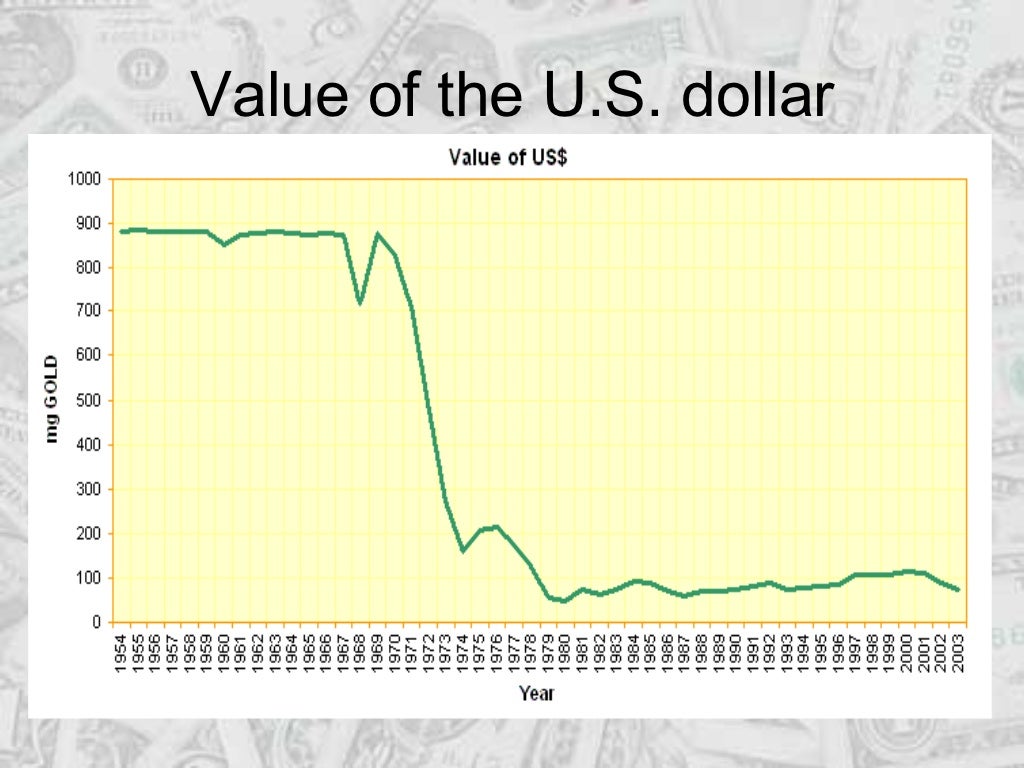The U.S. Dollar's Performance: A Historical Comparison To Nixon's Presidency.

Table of Contents
The U.S. dollar, the world's reserve currency, has experienced dramatic shifts in value throughout history. Understanding its past performance provides crucial insights into its current and future trajectory. President Richard Nixon's presidency holds a pivotal place in this narrative, marked by the momentous decision to close the gold window in 1971, a move that irrevocably altered the global monetary system and the U.S. dollar's role within it. This article will analyze the U.S. dollar's performance both before and after Nixon's decision to end the Bretton Woods system, comparing key economic indicators and identifying significant historical parallels.
<h2>The Bretton Woods System and the U.S. Dollar's Strength (Pre-1971)</h2>
The Bretton Woods Agreement, established in 1944, created a fixed exchange rate system centered on the U.S. dollar. This system pegged most currencies to the dollar, which in turn was convertible to gold at a fixed rate of $35 per ounce. This arrangement solidified the U.S. dollar's position as the world's reserve currency, facilitating international trade and investment. However, this seemingly stable system had inherent limitations. The U.S. faced growing trade deficits and persistent inflation, fueled partly by the Vietnam War and expanding social programs. These economic imbalances put immense pressure on the dollar, leading to speculative attacks from foreign governments and investors who sought to exchange their dollars for gold.
- Fixed exchange rates pegged to gold: This provided stability but lacked flexibility to adjust to changing economic conditions.
- The role of the US dollar as the world's reserve currency: This gave the US significant economic and political influence.
- Growing trade deficits and inflation in the US: These economic weaknesses undermined the dollar's value and the Bretton Woods system.
- Speculative attacks on the dollar: These attacks intensified the pressure on the U.S. government to maintain the gold standard.
<h2>Nixon Shock and the End of Bretton Woods (1971)</h2>
On August 15, 1971, President Nixon announced a series of economic measures collectively known as the "Nixon Shock." The most significant was the unilateral closure of the gold window, effectively ending the dollar's convertibility to gold. This decision marked the end of the Bretton Woods system and ushered in an era of floating exchange rates.
- Floating exchange rates replacing fixed rates: This introduced greater volatility into currency markets.
- Increased volatility in currency markets: Fluctuations in the dollar's value became more frequent and dramatic.
- Short-term economic consequences of the shock: Uncertainty and market disruption were immediate consequences.
- Long-term implications for the international monetary system: The shift to a floating exchange rate system fundamentally reshaped global finance.
<h2>The U.S. Dollar's Performance Post-1971: Periods of Strength and Weakness</h2>
Since 1971, the U.S. dollar's value has fluctuated significantly. The 1980s saw a period of strong dollar appreciation, partly driven by high U.S. interest rates. However, the Plaza Accord of 1985, an agreement among major economic powers to depreciate the dollar, marked a turning point. Subsequent decades witnessed periods of both strength and weakness influenced by factors such as interest rate policies, inflation rates, global economic crises (like the Asian financial crisis and the Global Financial Crisis of 2008), and geopolitical events.
- The strong dollar of the 1980s: This was partly due to high US interest rates attracting foreign investment.
- The Plaza Accord and subsequent dollar depreciation: This coordinated intervention aimed to correct trade imbalances.
- The Asian financial crisis and its impact on the dollar: The crisis led to increased demand for the dollar as a safe haven asset.
- The Global Financial Crisis of 2008 and its effects: The crisis initially weakened the dollar, but it later strengthened as investors sought safe haven assets.
- Recent trends and forecasts: The dollar's value continues to be influenced by a complex interplay of economic and political factors.
<h2>Comparing Key Economic Indicators: Then and Now</h2>
Comparing economic indicators before and after 1971 reveals significant differences. Pre-1971, inflation was relatively low under the Bretton Woods system, albeit rising in the years leading up to its collapse. Interest rates were also lower. Post-1971, the U.S. experienced periods of high inflation (e.g., the 1970s) and fluctuating interest rates, reflecting the challenges of managing a floating exchange rate system. Trade balances shifted from occasional surpluses to persistent deficits, a trend that continues to this day.
- Inflation rates before and after Nixon's shock: A notable increase in inflation followed the abandonment of the gold standard.
- Interest rate policies then and now: Monetary policy tools became more central in managing the economy after 1971.
- Trade balance comparisons: deficits vs. surpluses: The US shifted from a more balanced trade position to persistent trade deficits.
- Comparison of GDP growth: GDP growth patterns show variations influenced by both domestic and global factors.
<h2>Lessons Learned and Future Implications for the U.S. Dollar's Performance</h2>
The historical analysis reveals the crucial role of sound monetary policy in managing a stable currency. The inherent limitations of fixed exchange rate systems, as demonstrated by Bretton Woods, highlight the need for flexibility in responding to economic shocks. Global economic stability and geopolitical events continue to significantly impact the U.S. dollar's performance. Future fluctuations will likely be driven by factors such as the U.S.'s fiscal and monetary policies, global economic growth, and evolving geopolitical dynamics.
- The importance of sound monetary policy: Effective management of inflation and interest rates is crucial for maintaining a strong dollar.
- The role of global economic stability: Global economic shocks and uncertainty can significantly impact the dollar's value.
- The impact of geopolitical events on currency values: Geopolitical risks can lead to increased demand for safe-haven assets, including the dollar.
- Predictions for future fluctuations of the U.S. dollar: Forecasting future movements requires careful consideration of many interconnected variables.
<h2>Conclusion</h2>
The comparison between the U.S. dollar's performance before and after Nixon's presidency underscores the profound impact of the closing of the gold window. The shift to a floating exchange rate system introduced increased volatility, necessitating more dynamic monetary policy responses. Understanding this historical context is crucial for analyzing the current and predicting the future performance of the U.S. dollar. The U.S. dollar's future trajectory remains intertwined with global economic health, political stability, and the ongoing evolution of the international monetary system. Stay informed about the evolving landscape of global finance and continue your research on the U.S. dollar's performance to make informed decisions in the ever-changing economic climate.

Featured Posts
-
 Redick Supports Espns Handling Of Richard Jeffersons Exit
Apr 28, 2025
Redick Supports Espns Handling Of Richard Jeffersons Exit
Apr 28, 2025 -
 Bof A On Stock Market Valuations Addressing Investor Concerns
Apr 28, 2025
Bof A On Stock Market Valuations Addressing Investor Concerns
Apr 28, 2025 -
 Warna Baru Jetour Dashing Sorotan Di Iims 2025
Apr 28, 2025
Warna Baru Jetour Dashing Sorotan Di Iims 2025
Apr 28, 2025 -
 Debt Sales Impact A Look At The New Financials Of Musks X
Apr 28, 2025
Debt Sales Impact A Look At The New Financials Of Musks X
Apr 28, 2025 -
 Dows 9 B Alberta Project Delayed Collateral Damage From Tariffs
Apr 28, 2025
Dows 9 B Alberta Project Delayed Collateral Damage From Tariffs
Apr 28, 2025
